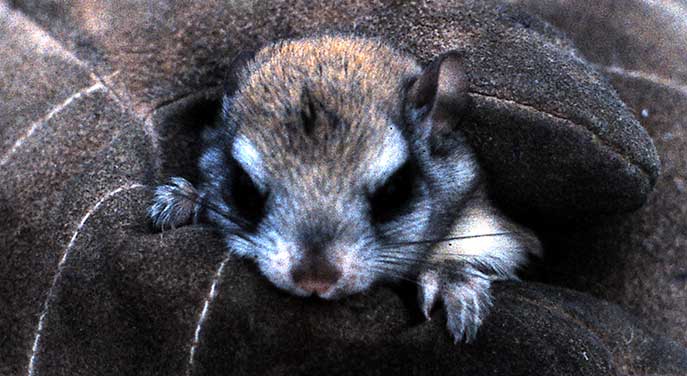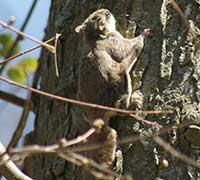 I have always marvelled at flying squirrels and their unusual abilities and biology. Two possible species can be found in Canada. The Southern Flying Squirrel is restricted to patchy appearances throughout our area but thrives best along the north shore of Lake Erie and into the U.S.; the Northern Flying Squirrel can commonly be found throughout much of forested Canada.
I have always marvelled at flying squirrels and their unusual abilities and biology. Two possible species can be found in Canada. The Southern Flying Squirrel is restricted to patchy appearances throughout our area but thrives best along the north shore of Lake Erie and into the U.S.; the Northern Flying Squirrel can commonly be found throughout much of forested Canada.
Fun Faunal Facts:
- Flying squirrels hide away in cavities in trees during the day, coming out to hunt at night. Their large eyes facilitate seeing low-light conditions as they search for food and predators.
- To succeed, these squirrels need tall trees growing close together so they can glide between them. A flying squirrel can’t actually fly, but it can glide for distances of over 75 meters. The longest known ‘flight’ of the Northern Flying Squirrel was approximately 100 meters! During a glide, they can make turns of up to 180 degrees.
- The life expectancy of flying squirrels in the wild is about four years due to the wide range of species that prey on them, but in captivity, a decade-long life is not uncommon.
- New World flying squirrels glow fluorescent pink under ultraviolet light, possibly to help them see and communicate better in low-light conditions.
- These squirrels use a wide variety of vocalizations, including sharp squeaking calls, soft chirps, chuckling noises, churring, whining and various musical whistles.
- Inspired by these flying squirrels, humans have made special suits that imitate the squirrel’s ability to glide. They are used by BASE jumpers and skydivers, allowing them to slow their descent and perform different maneuvers while flying.
| Click image for larger view |
| Related Stories |
| Some fun facts about chipmunks
|
| Is your cat outside killing wildlife right now?
|
| There’s room for everyone in nature – if we’re respectful |
I mentioned that these squirrels can’t actually fly, but assuredly they can travel significant distances between trees. They have a unique body feature that permits this form of travel. Along each side of their body, a flap of skin (called a patagia) stretches between the forelimbs and hind limbs and acts as a parachute allowing the squirrel to glide from perch to perch.
Gravity has to be factored in as these ‘wings’ don’t provide any lift, so, in essence, the squirrel starts high on one tree then glides down to the next – climbs that tree and then glides downward again and so on. Its flat tail acts as a rudder allowing it to turn and steer as it descends. Flying squirrels can turn by lowering one arm, while a specialized piece of cartilage (not found in other gliding mammals) extends from the wrist to support the patagia and help them steer. These animals are capable of making sharp turns to evade flying predators like owls.
The flying squirrel is a voracious hunter/gatherer, relying on foods as diverse as birds’ eggs and nestlings, fungi, nuts, buds, seeds, berries, insects, other invertebrates and sometimes carrion.
Habitat loss and feral and domestic cats take many squirrels, but a new threat has emerged. There’s been a dramatic decline in the fungi they eat due to the presence of Hemlock Woolly Adelgids, invasive insects that destroy the Hemlock stands where this preferred fungi flourishes.
While the Southern Flying Squirrel tends to breed twice a year, the Northern only produces one litter per year. This likely has more to do with the range of the two species and the limits of climate rather than physiological differences. The nest is generally located in mixed deciduous/coniferous forest tracts inside a tree cavity, rock crevice or nest box and is constructed of leaves, mosses, tree bark and lichens. Females alone care for the young, which are born blind, hairless and helpless.
So how do you tell them apart? Well, it’s tricky because they are very similar in appearance. Measurements can help (e.g. the Southern is less than 25 cm long), and you can look at the base of the hairs on the belly; they are white at the base of the Southern and gray at the base of the Northern. But assuredly, it is tough to tell them apart in the field!
Geoff Carpentier is a published author, expedition guide and environmental consultant. Visit Geoff on LinkedIn, Instagram and Facebook.
For interview requests, click here.
The opinions expressed by our columnists and contributors are theirs alone and do not inherently or expressly reflect the views of our publication.
© Troy Media
Troy Media is an editorial content provider to media outlets and its own hosted community news outlets across Canada.



